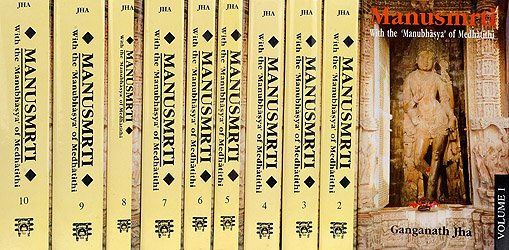Manusmriti with the Commentary of Medhatithi
by Ganganatha Jha | 1920 | 1,381,940 words | ISBN-10: 8120811550 | ISBN-13: 9788120811553
This is the English translation of the Manusmriti, which is a collection of Sanskrit verses dealing with ‘Dharma’, a collective name for human purpose, their duties and the law. Various topics will be dealt with, but this volume of the series includes 12 discourses (adhyaya). The commentary on this text by Medhatithi elaborately explains various t...
Verse 7.191
Sanskrit text, Unicode transliteration and English translation by Ganganath Jha:
संहतान् योधयेदल्पान् कामं विस्तारयेद् बहून् ।
सूच्या वज्रेण चैवैतान् व्यूहेन व्यूह्य योधयेत् ॥ १९१ ॥saṃhatān yodhayedalpān kāmaṃ vistārayed bahūn |
sūcyā vajreṇa caivaitān vyūhena vyūhya yodhayet || 191 ||He shall make a small number of men fight in close formation; but a large number he may extend as he likes. He shall make them fight, arraying them in the form of the ‘needle’ and the ‘thunderbolt.’—(191)
Medhātithi’s commentary (manubhāṣya):
If the men do not fight in a close formation, and extend themselves over a large space,—then, happening to be opposed by a larger force, they are apt to be overtaken in small detachments and thus, by sheer impact, become annihilated. For this reason, when the number of.men is small, they should, be mode to fight in close formation, so that fighting with mutual support, they do not become completely annihilated; and also when fighting dose by one another, through mutual rivalry and attachment they are enabled to fight the stronger enemy.
‘As he likes’—as much as he may wish, in view of the end to be served,—‘he may extend a large number of wirn’—i.e., make them fight in small detachments.
If the king thinks that when ordered to fight in small detachments, they may be struck with fear,—or that fear might arise in their minds on seeing the larger numbers of the enemy—then he shall array his men in the form of the ‘needle’ described above. The ‘thunderbolt array’ is that particular form in which the men are divided into three parts—one in the front, another in the rear and the rest on the two sides (of the king). In this ‘needle-array’ or ‘thunderbolt-array’ having arrayed his men, he shall make them do buttle. Of all arrays these two have been singled out for mention, as these two are best able to sustain a charge as well as to push home an attack. When he finds these same formations on the enemy’s side, then he shall resort to the opposite formation.
In the event of both belligerents being equal in number, the particular formations and their effectiveness shall depend upon the physical strength, loyalty and efficiency of the men engaged.
The term ‘shall make to fight’ implies that the king himself shall direct the operations from his quarters in a fortress or in some other comparatively safe spot forming the rear of the army. Says a work on the subject—‘The king shall go back to a distance of 200 bows (1200 feet) and stay there as the he engage in battle rear guard, for the purpose of rallying the men that may be routed; and in no case shall he be without such a rearguard’.—(191)
Explanatory notes by Ganganath Jha
This verse is quoted in Parāśaramādhava (Ācāra, p. 402):—and in Vīramitrodaya (Rājanīti, p. 404).
Comparative notes by various authors
Mahābhārata (12.100.47).—(The first half as in Manu).—‘When a small army is fighting against a larger one, the former should be arrayed like a needle-point.’
